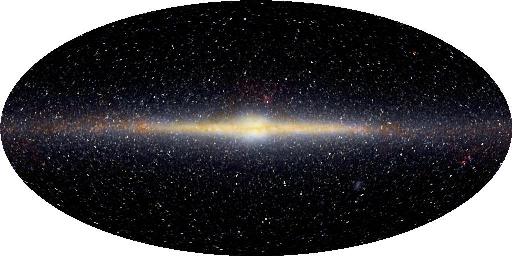
The Milky Way
The Milky Way is a gravitationally bound collection of roughly a hundred billion stars. Our Sun is one of these stars and is located roughly 24,000 light years (or 8000 parsecs) from the center of our the Milky Way.
COBE image of the Milky Way: (Courtesy of Ned Wright, click here for related images)

The Galaxy has three major components:
- A thin disk consisting of young and intermediate age stars - this disk also contains gas and is actively forming new stars. Dust in the disk makes it appear orange in the picture. Dust absorbs blue light more than red light and thus makes stars appear reddish. Our Galaxy has spiral arms in its disk - these spiral arms are regions of active star formation.
- A bar of older stars (white in the COBE picture).
- An extended dark halo whose composition is unknown. Since the matter in the halo does not consist of luminous stars, it does not show up in the COBE image. The existence of the dark halo is inferred from its gravitational pull on the visible matter.
Additional images of the sky from the COBE-Dirbe experiment.
Further Reading:
- Frommert, H. & Kronberg, C., " The Milky Way Galaxy", extensive web-based material.
- van den Bergh, S. & Hesser, J.E., "How the Milky Way Formed", Scientific American, January 1993.
- Ferris, Timothy, "Coming of Age in the Milky Way", An excellent popular astronomy book.
